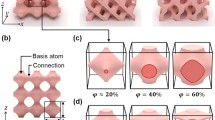Abstract
In this paper a metamaterial sheet constituted by a periodic pattern of square tensegrity cells (T-bar) subjected to a uniform equibiaxial pressure is studied. In particular, a minimal mass lattice is analytical determined by imposing stability and material failure conditions. Interestingly, the shear stiffness of this optimized lattice is very small in comparison to the other moduli and exhibits a linear dependence on the applied load. This behavior suggests the interesting possibility of tailoring new materials with force tunable shear modulus.






Similar content being viewed by others
Notes
Here we are considering the half cables associated to a single cell.
The double index notation indicates the symmetric (s) and antisymmetric (a) character (see Fig. 3) of the generalized displacements, with the first index referring to the horizontal axis and the second index to the vertical axis. In particular, \(u_1\) and \(u_2\) are s–s variables, whereas \(u_3\) is an a–a variable. \(u_4\) and \(u_5\) are s–a variables, whereas \(u_6\) and \(u_7\) are a–s variables.
References
Amendola A, Krushynska A, Daraio C, Pugno N, Fraternali F (2018) Tuning frequency band gaps of tensegrity metamaterials with local and global prestress. Int J Solids Struct 155:47–56
Chen H, Chan C, Sheng P (2010) Transformation optics and metamaterials. Nat Mater 9:387–396
DeTommasi D, Maddalena F, Puglisi G, Trentadue F (2017) Fractality in selfsimilar minimal mass structures. J Mech Phys Solids 107:433–450
DeTommasi D, Marano G, Puglisi G, Trentadue F (2015) Optimal complexity and fractal limits of self-similar tensegrities. Proc R Soc A 471:20150,250
DeTommasi D, Marano G, Puglisi G, Trentadue F (2017) Morphological optimization of tensegrity-type metamaterials. Compos Part B Eng 115:182–187
DeTommasi D, Puglisi G, Trentadue F (2019) Elastic moduli of optimal tensegrity-type metamaterials. Front Mater 6:1041–1048
Fang N, Xi D, Xu J, Ambati M, Srituravanich W, Sun C, Zhang X (2006) Ultrasonic metamaterials with negative modulus. Nat Mater 5:452–456
Fraternali F, Carpentieri G, Amendola A, Skelton R, Nesterenko V (2014) Multiscale tunability of solitary wave dynamics in tensegrity metamaterials. Appl Phys Lett 105(20):201903
Fraternali F, Senatore L, Daraio C (2012) Solitary waves on tensegrity lattices. J Mech Phys Solids 60:1137–1144
Hutchinson R, Fleck N (2006) The structural performance of the periodic truss. J Mech Phys Solids 54:756–782
Ingber D, Stamenovic D (2014) Tensegrity, cellular biophysics, and the mechanics of living systems. J Rep Prog Phys 77:046603
Krushynska A, Bosia F, Miniaci M, Pugno N (2017) Spider web-structured labyrinthine acoustic metamaterials for low-frequency sound control. New J Phys 19:105001
Motro R (2003) Tensegrity. Kogan Page Science, London
Oliveira MD, Skelton R (2009) Tensegrity systems. Springer, New York, pp 1–216
Paulose J, Meeussen A, Vitelli V (2015) Selective buckling via states of self-stress in topological metamaterials. PNAS 112:7639–7644
Sabouni-Zawadzka A, Gilewski W (2019) Soft and stiff simplex tensegrity lattices as extreme smart metamaterials. Materials 12(1):187
Schittny R, Buckmann T, Kadic M, Wegener M (2013) Elastic measurements on macroscopic three-dimensional pentamode metamaterials. Appl Phys Lett 30(103):11,905
Funding
D. De Tommasi and G. Puglisi have been supported by the Italian Ministry MIUR-PRIN project COAN 5.50.16.01, code 2015JW9NJT. G. Puglisi has been supported by the MIUR-PRIN project 2017KL4EF3.
Author information
Authors and Affiliations
Corresponding author
Ethics declarations
Conflict of interest
The authors declare that they have no conflict of interest.
Additional information
Publisher's Note
Springer Nature remains neutral with regard to jurisdictional claims in published maps and institutional affiliations.
Appendices
Appendix 1
Here we give the explicit form of the relation
In view of (18), (19) and (20) the incremental compressive axial force \(N_{[1]}\) associated to the biaxial compression force \(fl=1\) can be determined as
It is should be noted that Eq. (40), based on the superposition principle, can be applied to the present non-linear problem since no geometrical stiffness terms are present in (41). By using (21) and (22), we further find
Now, for sake of simplicity, we consider that in all the numerical examples here presented we always have \((\beta -1)< 0.004\). Thus we limit our analysis to the case \((\beta -1)\ll 1\) for which we have
Then (40) can be written as
Finally, we find the allowable range for the parameter \(\alpha\). This is determined by the condition
that, in view of (44), leads to
Appendix 2
In Fig. 7 we plot the optimal length \(l_0\) for different values of the load f and limit strain \(\varepsilon _y\). In the figure, by considering a steel based metamaterial, we assume \(E=207\) GPa. Moreover we consider a prestress parameter \(\beta =1.02\) and circular sections, so that \(\xi ^2=4/\pi\).
Rights and permissions
About this article
Cite this article
De Tommasi, D., Puglisi, G. & Trentadue, F. Tunable shear stiffness in a metamaterial sheet. Meccanica 54, 2029–2037 (2019). https://doi.org/10.1007/s11012-019-00994-5
Received:
Accepted:
Published:
Issue Date:
DOI: https://doi.org/10.1007/s11012-019-00994-5





